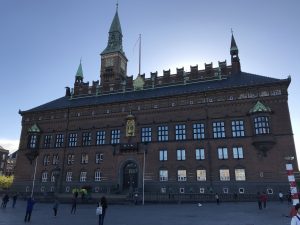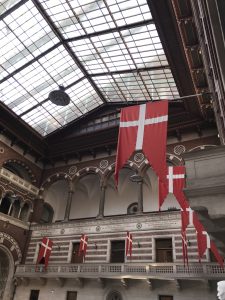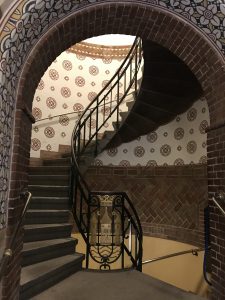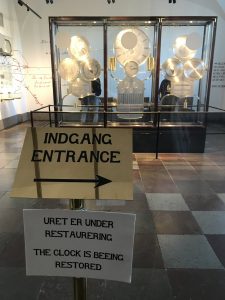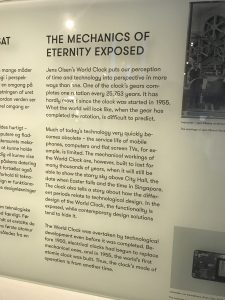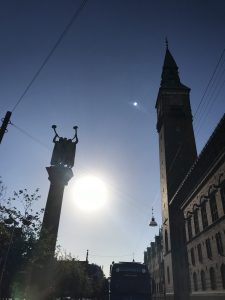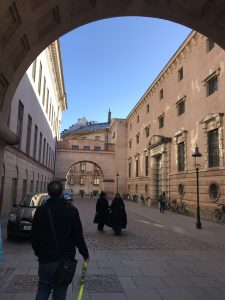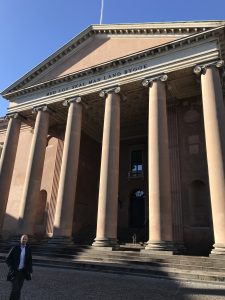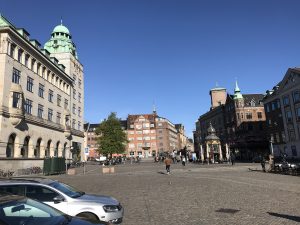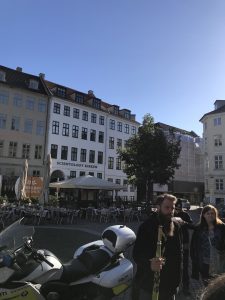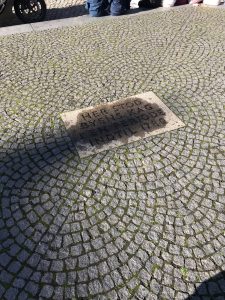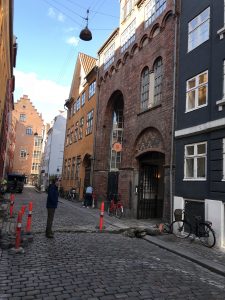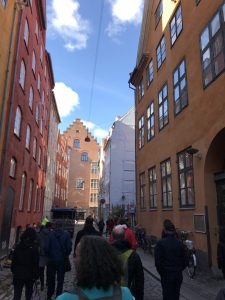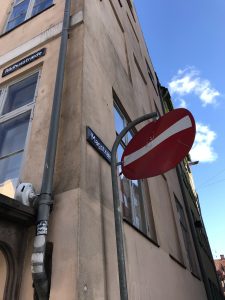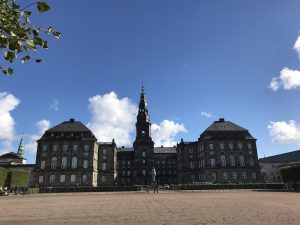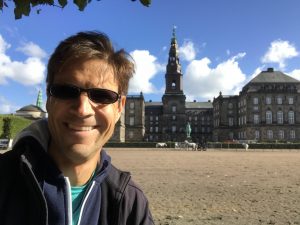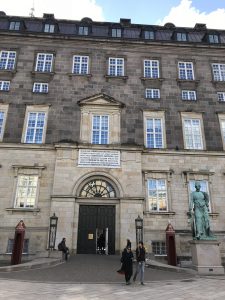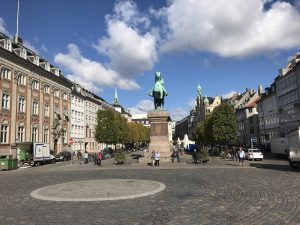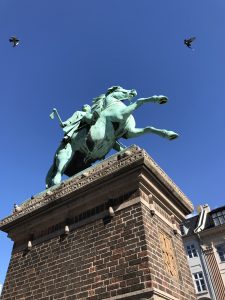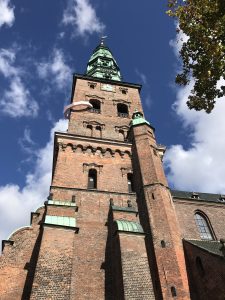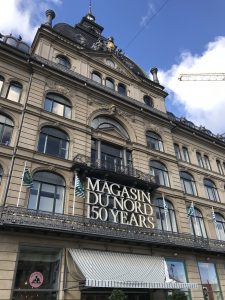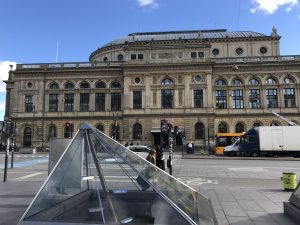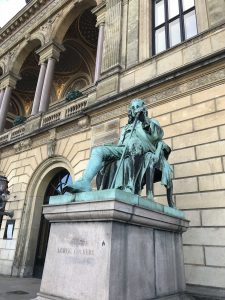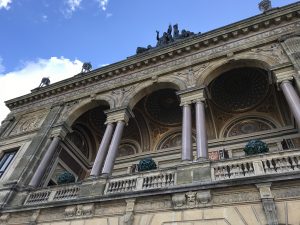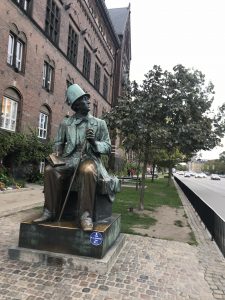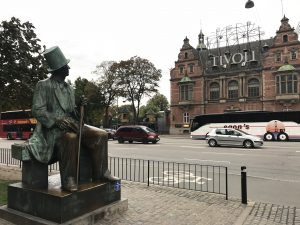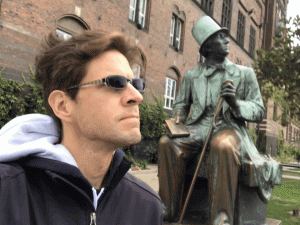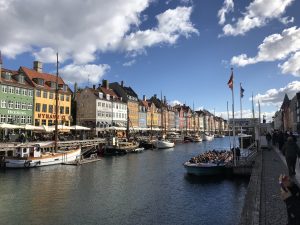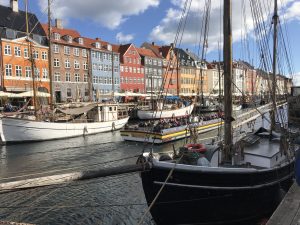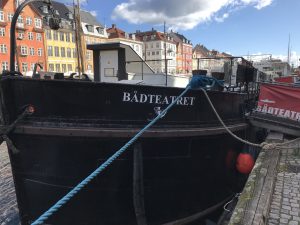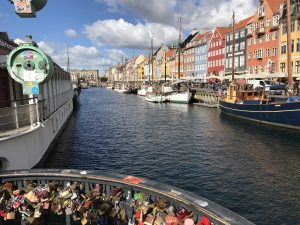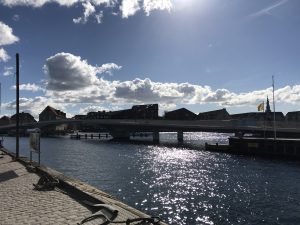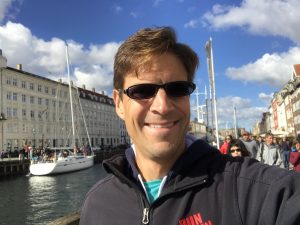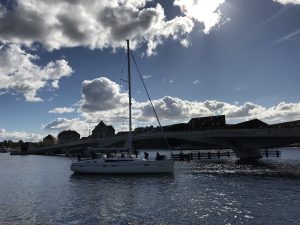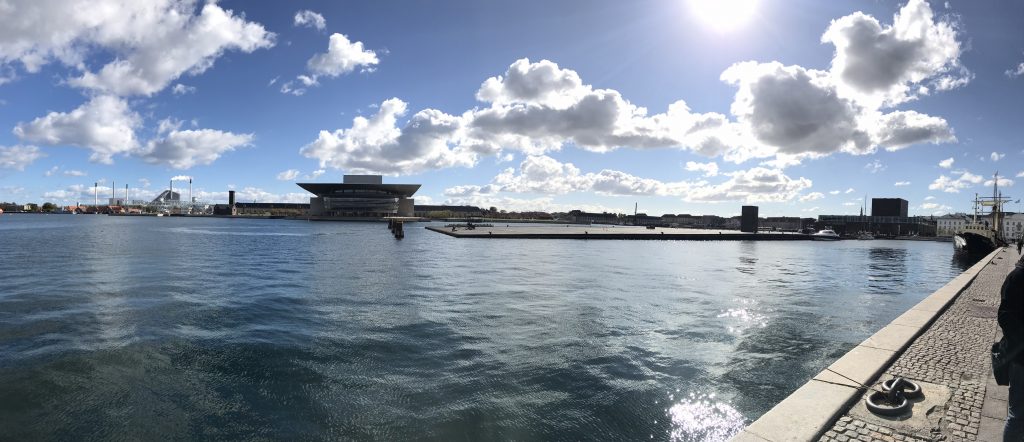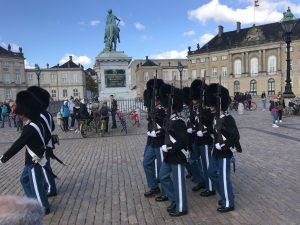It’s a three hour walking tour with a British ex-pat who has been living in Copenhagen for the last 10 years. He had planned on staying for a year… and, well, he fell in love with the city. While Vienna and I never seemed to click, I understood the appeal of this Danish capital. It’s a compact city with a manageable population such that while there are moments when things seem a bit “busy,” it never feels stiflingly crowded. The biggest safety issue seems to be the speeding bicycles whizzing to and fro; I am repeatedly warned that cars will stop for pedestrians but bikes will not. I am also told the only thing more dangerous than a local “Viking Biking” is a tourist on a bicycle… but if you’re struck by one, you aren’t really going to be asking where the biker’s from.
We met at the City Hall, a building that houses Jen Olsen’s famed world clock. It’s a mechanical marvel that, amongst various other horological aspects, tells the time locally, across the world’s time zones, and on a celestial level, the latter such that its gear moves only once every 25,753 years. Unfortunately, as the clock is apparently “beeing” repaired (I’m unclear if it’s a typo of if bees got into the mechanism), it’s not running at all. Time has been frozen on the world clock, according to its day and date function, at 16 December 2017. This is all the more ironic to me as there is an informational placard saying how wonderful to see something built to last and not be disposable in this era of constant incremental upgrades supplanting last year’s models and rendering so much of the past as obsolete. In this case, due to its various time iterations, this broken clock it isn’t even right twice a day.
It turns out this City Hall is actually the fifth one built, opening in 1905. Copenhagen is apparently prone to disastrous fires, so much so that one of its city symbols is a fire-breathing dragon. To be fair, if the history books are to be believed and Bishop Absolan founded the city in 1167 (more on this in a bit), then the town did pretty well fire-safety wise for 500+ years. In 1728, a fire broke out at the most popular restaurant in town (its name lost though) that consumed 50% of the city. A third of the city was homeless. And the family that owned the restaurant? They blamed their 7-year-old kid for starting it. I really, really hope his name was O’Leery.
The SECOND great fire of Copenhagen occurred in 1795 and burned the OTHER half of the city.
And there are more fires to come… but we’ll get to them in due course. In the meanwhile, next to the City Hall are the dynamic duo of Lur blowers. These war trumpeters have been silent for some time, albeit as is often the case with statues, the legend says they’ll blow their horns if a virgin should walk past. These kinds of stories always make me sigh. My college has a similar tale told about a thankfully toppled (though probably since restored) civil war soldier statue known as Silent Sam… who would fire his musket if a virgin walked past. There are only so many stories in the world and why this one keeps getting recycled is probably because it enables tour guides to say the word “virgin” and elicit titters from the crowd.
I sound like a prudish hen clucking about such things.
***
The tour then took us into the “Old Town” of Copenhagen. In the City Hall Square you’ll find Gammeltorv, the old square, with its fountain, and Nytorv with its public execution slab. So, ya know, you could have a drink and see a beheading – dinner and a show. Three City Halls got burned down here, as much of the city had been made of wood for so long and thus was little more than a tinderbox waiting to be set ablaze. On the fourth City Hall, they got smart and built the place out of stone, and that building has survived since 1650. Today it remains in use as a courthouse.
***
Nearby is the Knabrostraede, home to JC Jacobsen. For years, beer was an unreliable drink – sometimes it was good, sometimes it was terrible (me, I usually think it’s always terrible but I never “acquired the taste” for it). In 1811, a local brewer and scientist experimented with yeast and realized he could consistently crank out the same tasting beer. With consistency and a good flavor in his corner, Carlsberg Beer became a huge, huge hit. He named it after his son… who was so appreciative that he went off and founded his own brewery to compete with his dad.
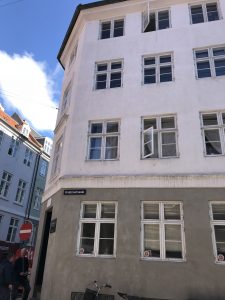
A man of science, JC Jacobsen gave his yeast secrets to the public, believing that information and knowledge should be free and open. It also helped then establish plenty of competition in the industry, such that he and his son reconciled and merged their companies back into the Carlsberg brand and became just about the most powerful brewer in the world at that time. They’re still up there, even today.
We would hear about JC Jacobsen some more throughout the tour as he was a great philanthropist and generous with his money to the city he loved. Lots of statues, monuments, and infrastructures came about because of his beer money.
***
James, our tour guide, wanted to show us the oldest street in the city. He believes it to be so as there was a citywide 850 anniversary celebration recently and as part of the festivities there were all these old maps of the city throughout the ages. The only street that was on all of them was this one – Maelstralle. Unfortunately, today it’s under repair/construction, as much of the city seems to be. Part of this is regular upkeep and part of this is to do with Copenhagen’s attempt to greatly increase its metro system by adding 18 more stops hither and yon.
It was also on this street that during the Second Great Fire of Copenhagen (1795) the city demolished buildings to create a fire break which saved the half of the city that was already torched in the First Great Fire.
Oh, and a scene from The Danish Girl was shot here. But since it stars that no talent hack Eddie Redmayne I’ve never seen it. (I have however seen his “you-should-return-your-Oscar” performance in Jupiter Ascending… yeesh).
***
From there it was on to the House of Parliament. Denmark if the only government in the world that has all three branches of its government housed in the same building – the parliament, the Prime Minister, and the Supreme Court are all in the “Borgen” or more properly Christianborg Palace. Like so much of Copenhagen, there had been a couple of fires here. This is the 3rd Palace building.
A bit of history – Bishop Absalon is tasked with fortifying the fishing town and organizing it in the 12th Century. The Royals moved to Copenhagen in the 1400s and by 1433 they had declared it the capital. By the 1600s/1700s there was a “keeping up with the Joneses” thing happening wherein everybody was building opulent palaces and everybody was trying to top everybody else. Thus an opulent palace was built here in 1730. Sixty years later, a fire in the opera house section of the place consumed it. So the Danes rebuilt theirs on the same spot (this is Christianborg 2.0). They got smart and put water tanks in the basement and pipes everywhere to devise a sort of sprinkler system. All well and good for 110 years when a fire broke out in the kitchen. Unfortunately, nobody knew how to work the sprinkler system as that knowledge died with the previous generations. So we wind up with this 3.0 version… years later the Royals would move to Amalienborg where the Royal residences remain to this day. Since 1910, the “Borgen” has been home to the Danish democratic government branches.
Quick political history lesson:
With the exception of the current monarch (Queen Margaret), all the previous rulers were either Christian or Frederick… only the numerical addendum changes. There’s about nine of each, alternating reigns. So if you’re ever on Jeopardy, and it’s a question about Danish monarchs, you got about a 50/50 shot it’s either C or F. If they ask for a number, well… that’s worse odds to be sure. 1:18 or something. Wait, is it 1:17 because the one is part of the set of 18? I was never very good at odds. It’s one of the many reasons I so dislike Las Vegas.
On the democratic side, there’s almost always coalition governments as there are nine parties in Denmark. Compromise is necessary and so you have to try and negotiate out deals to appease various factions. Is that better or worse than a two party system? Right now I feel like it’s better… but in truth, it already feels like there are more than two parties in the USA. I’m not sure the Republican Party exists as a single entity anymore.
And maybe the Danish government is on to something in their policies. Denmark has consistently been named one of happiest countries in world. For a while they were number one, but they’ve recently dropped down to third place, behind Finland and Norway. But as our guide was quick to point out, that’s okay – the only important thing is that Sweden is a very distant 9th. They really hate the Swedes!
The government is well funded as the nation is amongst the most highly taxed in the world. There’s a 25% sales tax. The lowest bracket on income tax is 39.5%, while average overall is a little over 51%. A new car is charged 180% tax, such that the saying is you buy one car for you and two for the government. It may also help account for the number of bicycles on the road.
In return though, the country is abundant with services. There’s quality infrastructure and a high standard of living. Higher education is not only free tuition, but the government kicks in a monthly stipend for students’ living expenses. As a result, the people are typically highly education and debt free. Healthcare is 100% free and there is 12 months paid maternity leave. When going back to work, there’s a highly subsidized childcare package. On top of that, the nation has targeted 2025 as the year they go completely carbon neutral. There’s a big push on this, such that every new home built has to have an electric car charging outlet (electric cars have a huge tax rebate on that 180% deal!). So while there’s a lot of tax, there’s a lot of services too. Better or worse than other systems?
I will say Copenhagen is expensive. Since I base most of my analysis on food and specifically gelato, a one scoop cone runs about 30 danish kroner… or about USD$5. To play the awful Italian accent stereotype – “That’sa one pricey ice-a cream!”
***
We found ourselves at Højbro Plads, where yet another large statue of Bishop Absalon can be found. Looking as always less like a Bishop and more like a Braveheart Cosplayer, he’s sporting a battle axe and looking toward Sweden, ready to declare war on ancient adversaries. While you’ll recall the history books say he founded the city in 1167, it should be noted that HE wrote the history and people took him at his word. But recently, as part of the subway excavation, the Danish have found a much older city in the strata, leading many to wonder just who did found the city proper and when? The debate has only just begun. And I suppose it’s yet another reminder that history is written by the victors… but evidence will out.
***
The St. Nicolas Church Spire features a ring that looks like a bike lock. It apparently is part of an art exhibit currently going on in this modern art museum and will most likely disappear when the next exhibition moves in. The currently misleading appellation for Church at Kunsthallen Nikolaj is because it was a church… until it, yup, burned down. The Second Great Fire took out everything EXCEPT the tower, which has survived intact since the 1390s. After the fire in 1795, it was decided to rebuild the ground floor as a fire station – a pretty good idea given the proclivity for fires to destroy large swaths of the town. Eventually when the wooded construction tinderbox was replaced, little pig style, with brick and stone, the fire station could be relocated and the building was transferred back to the city. It reopened as a market hall and over the years has since morphed into an art museum and a wine bar.
The spire itself was a gift from the Carlsberg found, JC Jacobsen. And his charitable foundation continues to this day, offering support and grants throughout the city. Other artful contributions to the city include the Dragon Fountain outside City Hall # 5 as well as those horny Lur blowers.
The Foundation is also responsible for the third least impressive tourist attraction in Europe… but a little more on that in another post, as I feel like that’s a whole thing that needs a bit of it’s own space.
***
The Magasin Du Nord is one of the city’s oldest and most grand department stores. Like the name above theirs implies though, it used to be a hotel and only changed hands 150 years ago. Back then it was across the way from the other main building in this area – the National Theater, a place that housed the city ballet, symphony, and choir.
This is then the story out guide tells us: To this hotel then a 14-year-old boy comes to pursue his dream (14 being considered an adult at that time). To dance! And so he stalked the ballet director all over town, going wherever she went, following along, until finally she asked him what he wanted. To audition, of course! And she relented… and he was awful, just terrible, deemed by the director one of the worst dancers she’d ever seen. But the stage was calling so he decided to try his hand at acting. Thus from his hotel across the way he once again stalked an artistic director, this time, the theater company’s head honcho. Same thing, all over town, finally the guy relents and he gets an audition – kid’s a terrible actor too. So he decides to try singing and before he can stalk the choir director, the man cuts out the middle bit and just offers him an audition hoping to resolve this quickly. Turns out, kid’s got a lovely singing voice. Great soprano – great acclaim with the choir, that is until… puberty. His voice changes and his career is over. But his friends in the various arts tell him that he always tells funny, interesting, and imaginative stories and what he really ought to do is write. And they chip in to send him to school to learn how to write. And he does. And that boy’s name, was Hans. Hans Christian Andersen.
All told, HCA cranked out 3,500 works in Denmark, from fairy tales to poetry to tales both large and small… including an icy snow queen and a little mermaid… albeit those who are looking for a happy ending might want to let it go.
***
Around the corner is Nyhavn, the “New Harbor.” King Christian IV, known as “The Builder” because he did so much for the city expansion and infrastructure wise, wanted to turn Copenhagen into an international marketplace in the late 1400s/early 1500s, and thus wanted to use a channel to bring goods in and out of the city. From there the New Harbor was born. The one “downside” is it became something of a den of inquity due to sailors making various uses for it as part of shore leave… eventually the ships got to be too big for the harbor and Copenhagen built a bigger one farther afield. The place really fell into disrepair but saw a real revival in the 1950s. These days it’s a lovely overpriced tourist trap that you should just bring your own bag lunch to and sit on the wall to enjoy… that is if you’re a savvy local and informed tourist like us good folk on this walking tour.
***
Across the harbor in Christiana is the “New” Opera House. It opened in 2005 at a price of over 500 million euros, funded entirely by the owner of the Maersk shipping company. AP Moller knew what he wanted and so despite hiring the guy who designed the Sydney Opera House, he dictated what he wanted and expected Henning Larsen to just draw what he was told. Not an ideal working relationship so Larsen slipped in a few easter eggs. Apparently, Moller hated Christiana (more on this in the other tour), a hippie enclave and home to the “green light district” and marijuana sales galore. One of the symbols of the area are three bright circles… which Henning incorporated into the three main chandeliers hanging before the glass paned windows that Moller demanded.
A lot of people say it looks like a toaster. Moller wanted it to look like the conn of a container ship. Eye of the beholder. Is it a chalice or two faces? A witch or a young lady?
***
We finished the grand tour on the Fredericksborg Axis – the Opera House to the Royal Palace to the Marble Church (which is made of 100% limestone… but, hey, it’s all in the branding).
The changing of the guard happens every two hours but the biggest ceremony is at noon – here’s a glimpse.
As for the complex itself, it started as a plan of Frederick V to put the wealthiest in a protected suburb away from the riffraff. Over the year though, the royals bought up the four biggest mansions in the square and have maintained it ever since.
Quick note on current Monarch Queen Margaret. She’s reigned since 1972 and remains immensely popular – something like 85% approval overall. She has four degrees, speaks six languages, is a bohemian artist who paint and often designs and sews her own official wardrobe that might best be described as ‘Bjork’-ian and in a bizarre anecdotal footnote, personally translated into Danish the complete Lord of the Rings trilogy in the 1970s… she even hand illustrated the first edition.
Her son Frederick is next in line and lives across the way with his Australian wife Mary and their four young kids. They are apparently even more popular than Margaret and often you see them out and about town, running errands, biking their kids to school, running. In fact Frederick at 48 years of age, recently posted a 3:15 marathon time.
Jerk.
***
Herein ends the Grand Tour… next though I’ll tell you the story of the Three Least Impressive Tourist Attractions of Europe. But first, some meatballs that my guide swears puts those fabled Swedish meatballs to shame.
Back in a jiff.

